What It Takes To Be This ‘Special Breed’ Of Runner

With flag in hand, they are easily spotted within the crowds of the corral. They chat with us, helping ease the pre-race jitters and run alongside us the entire time. They are a motivator. A distraction. A clock. A teammate. A course expert. A coach. They are the race pacer, a “special breed” of runner that endures the long distance race so that others can reach their goals or set a new PR.
There are people I know that wouldn’t run the distances we do, let alone pay to do it. But these people willingly do these races, leading a tribe of runners—not for themselves, but strictly to help others.
What kind of racer is willing to run for others? Why do they do it and what is it like for them?
After speaking to race pacers I found this: pacers are absolutely selfless runners. They pace to help other runners, completely giving their all to see others succeed. I also found out that they are full of this energy and excitement when speaking about their experiences. The passion and drive are there. They actually enjoy doing it.
They don’t shy away from the fact that racing longer distance is challenging for everyone, even them. But they embrace it and are able to focus, yet multi-task—all while racing themselves.
They don’t do it for recognition but deserve to be in the spotlight. Here are their stories, and everything you need to know about the role of a pacer.
Why They Do It?
Giving Back
One of the most common reasons as to why runners take on the role of a pacer is to give back to the running community and help other runners make it to the finish line.
“When I first started racing I utilized the race pacer—even to this day I utilize race pacers—depending on my goal is and what race I am doing,” North Carolina-based pacer Keira Sciance told RunnerClick. “So I felt like to pay it forward, I would do the same thing to help other people achieve their goals.”
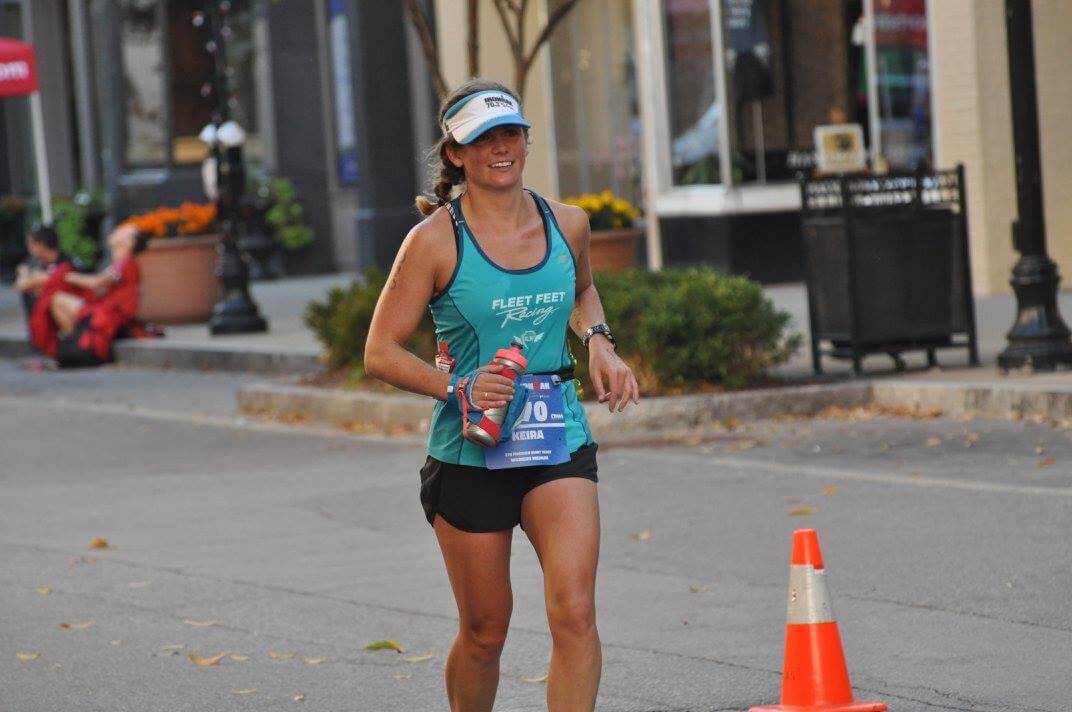
Sciance might’ve relied on the support from a pacer to get through her first race, but she would go on to complete about 10 half marathons, 5 marathons, Ironman races, plus completing a 50k and 40-mile race within the past two years.
Along with training for her own races, Sciance is a frequent pacer, typically leading the 1:45 group at half marathons. Occasionally she is a pacer for the 2-hour group, which is a bit slower for her. But she doesn’t think about her personal race pace. Instead, when pacing it’s about what that ideal pace the runner knows they can consistently handle even on the worse of days such as having tired legs or just being “off.”
“I go into the race knowing that is not my intention,” she said when asked if she ever feels slowed down in a race. “That specific race is not my race. I am doing it for other people,” the ultra runner said.
And other pacers do it to inspire, sharing their personal stories to show that every runner has it in with them to get to that finish line.
“Running has given me so much,” pacer Avi Kelley said. Now a member of the group Marathon Maniacs and a half marathon pacer, Kelley began running just over four years ago after being overweight with a list of health complications. Since taking up running, he has lost 100 lbs and gained so much more—like lots of friends in the running community. He has completed a few half marathons and marathons including his first, the Marine Corps Marathon in 2015.
After finding out a local race needed a last minute pacer, he asked his running buddy what it takes to be a pacer and decided this was an opportunity he couldn’t pass up. The ambassador of the running store Running Etc has gone on to pace races 25 times including local races in Virginia Beach, as well as Disney races and Rock ’n’ Roll races.
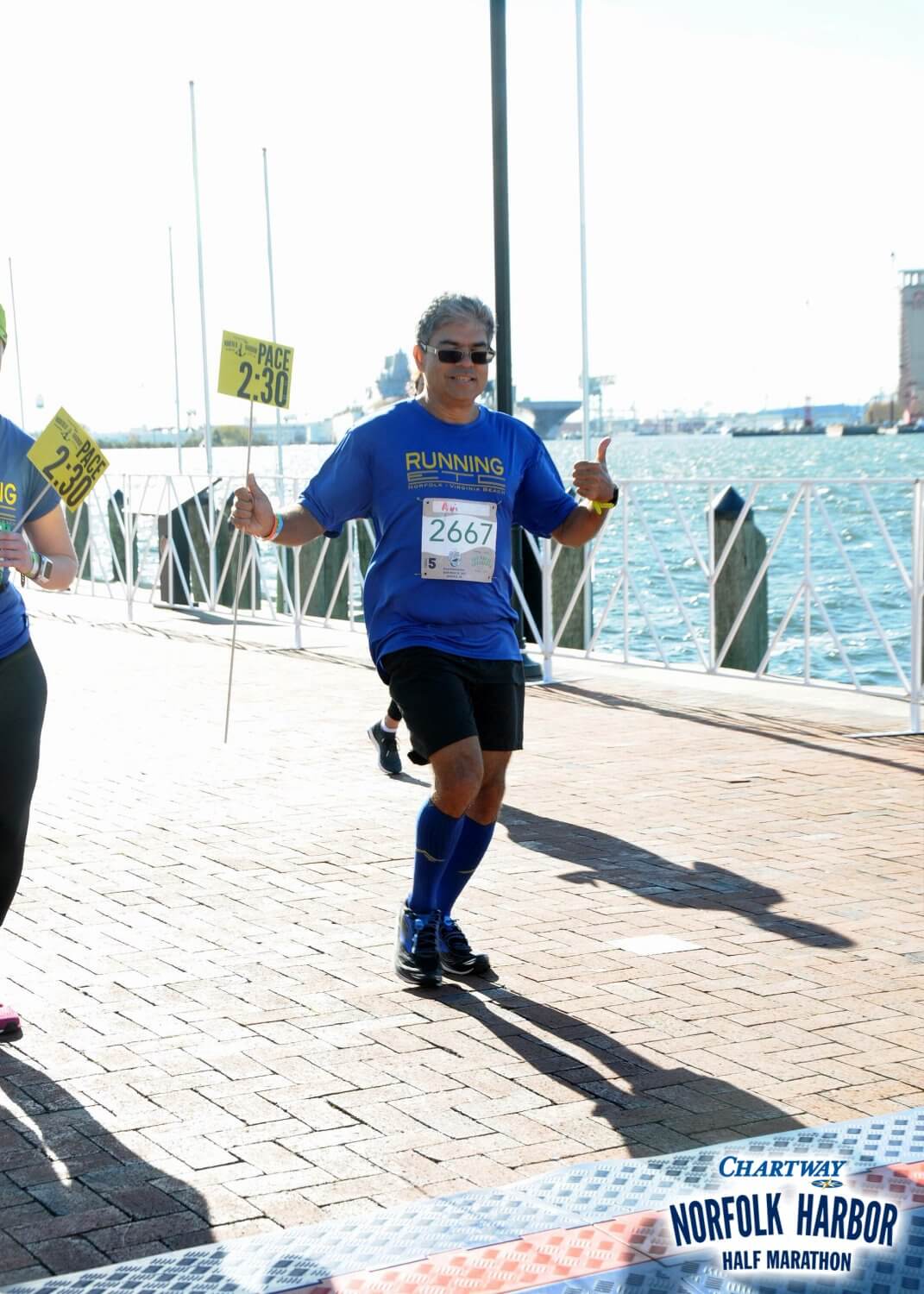
After Reaching Their Own Goals
Pacers are able to abandon their own race goals, for some, because they have seen success and want to share that feeling with those who are striving to be their best on that given day.
“I feel like I accomplished a lot as a runner for myself. And I’ve wanted to help others meet and exceed their goals,” pacer Aaron Mendelsohn said. “It’s as gratifying for me to pace as it is to race.”
And Mendelsohn is no rookie to racing. The popular pacer in New York and the surrounding areas experienced what he calls a “running renaissance” in 2011 as a masters runner. He’s run 5ks with great success by placing in the top 3 for his age group. He has run half marathons and marathons, winning the Hampton Marathon in 2013. And while he still loves to race, he began pacing since roughly the last four years. This includes pacing the 3:15, 3:10, 3:05 and in 2017 the 3-hour group for the NYC Marathon, as well as the 1:30 group for the NJ Half Marathon.
There comes to a point for runners when they are happy with their successes and as they continue to chase their own running achievements. They begin to give back and participate in races in a way that is fulfilling to them. We all know what that feeling is like to cross that line, now imagine how it must feel to do so carrying a pack of other runners to their own personal victory.
“It’s wonderful to be able to speak with runners and get them excited about the times they are trying to hit,” Mendelsohn said. “It’s another way to be a part of people’s goals and an incredible race.”
The Personality Of A Pacer
It takes a certain kind of person to be a race pacer. I would go as far as to call them a rare breed—and I mean this in the most endearing way. Sciance calls them special.
“I think that it does take a little bit of a special person to race for other people and not just for yourself,” she said. “But runners are a special breed, so I think that a lot of runners go into to help others.”
A pacer needs to have a personality. This is something Kelley stresses. This includes being “enthusiastic and friendly.”
“I think that’s the most important part of pacing is that I have a good story to tell people,” Kelley said. “Especially during the latter half of the run. A lot of those runners are struggling. You have to keep them motivated.”
To do so, he tells them his story of weight loss through his running journey. Other times its bad running jokes, or telling people where he comes from and stories of his past.
“It’s always trying to keep people distracted. Asking people where they are from, or how they got into running. It gets their mind off of it,” he said. “At the same time as I’m doing that I am keeping my eye on the watch, on the mile markers. I’m keeping my eye on the pace band all at the same time.”
For Sciance, she takes a partnership approach to pacing. She often paces races that have dual pacers per pace groups. This is so that if one drops out the organizer isn’t left scrambling last minute. It also helps the pacer with accountability.
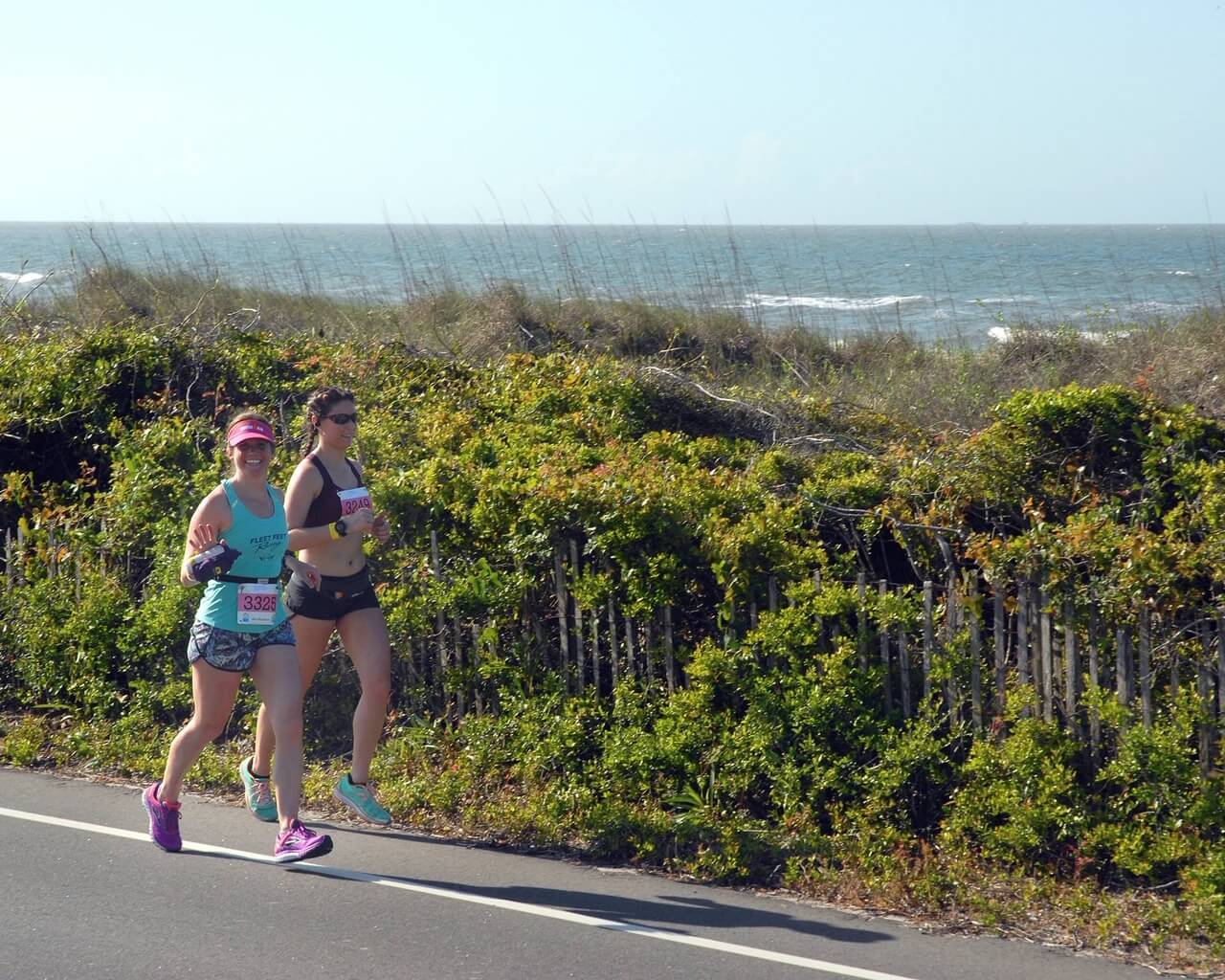
“I pace a lot with one specific person in town, and we have different personalities,” she said. “I’m more business-like; we need to stay on pace and I’m watching the clock. And she’s the social butterfly. She does all the talking. She distracts from racing and I’m very different.” This allows them to do both aspects of pacing as a joint unit.
Mendelsohn’s passion for racing and pacing shines through. His vivacity is contagious, sparking excitement into the run. One could argue that is is another example of having that personality to be a pacer.
After he finishes a race he stays at the finish line, cheering, hugging and giving high-5s the folks he’s been running with. “You have a bond with them.”
The Responsibility Of A Pacer
Being a pacer isn’t all fun and games. It’s not easy. The runner needs to one, be trained to run the race, and two do it in that time they are pacing without a doubt because those runners are counting on you. “You need to have a great personality, but you need to be able to stay on point,” Kelley said. “A lot of people think you walk off the streets and start pacing, but that is not the case. Pacing is a huge responsibility. I take it very seriously.”
Pacers start off in their corral holding a sign or flag for identification purposes.
“Typically you run with it for the first mile or so and then ditch it,” Sciance said.
Other pacers hang on to that flag and wave it proudly. “After the first mile or two I don’t even know I am carrying it,” Mendelsohn said. “I switch hands, I wave it around. It’s become a part of me now. My first time pacing maybe [it felt heavy to race with], but now it’s another appendage.”
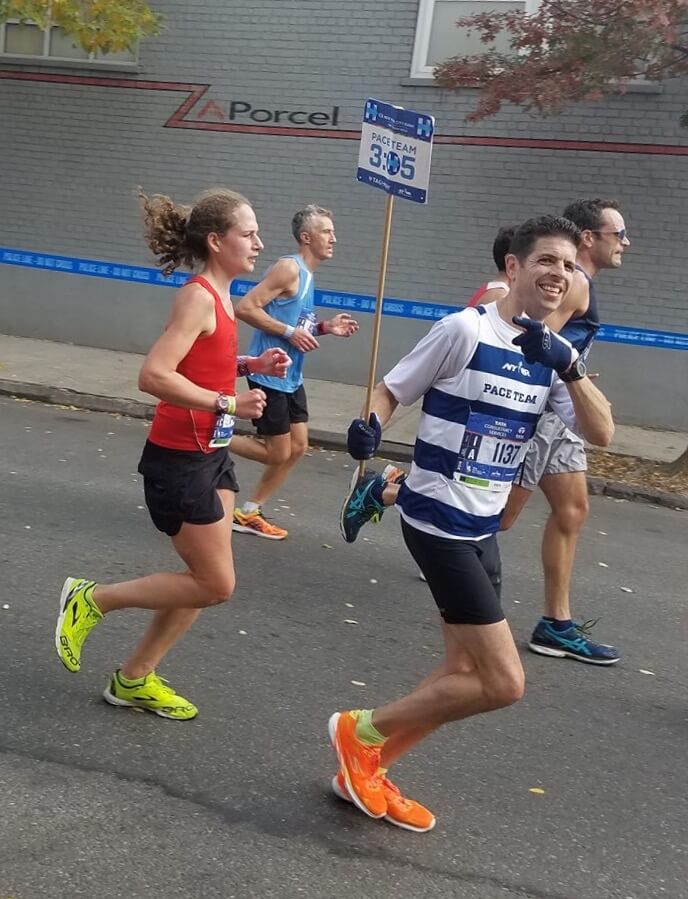
He holds the flag the entire race. “I wave it high, and sometimes I run backward if I’m feeling good, and I shout, ‘Come on. You can do this! Just stay with me. We got this.’ It’s one of my responsibilities to have the enthusiasm when people’s energy is zapping.”
Besides a flag or sign, Sciance revealed pacers are given wither a singlet or T-shirt so racers can identify them. This is also helpful for those looking to link up with a pacer along the course.
“What most pacers will do is print out a little pace band, so at every mile at glance the can see then need to be at 9:09, 18:08, and so on,” Kelley said. “[Pacers need to] look at that and making sure your watch is in sync.”
For seasoned pacers like Kelley, the pace becomes “automatic.” This feeling of being on autopilot helps when trying to motivate and continuously be doing the math.
What many might not know is that pacers need to finish 30 seconds to a minute faster than the pace time so that it gives enough time for the runners following the pacer to finish the race in that time.
“I spend so much of the race looking at my Garmin, which is on my left hand, looking at my race band, which is on my right wrist, and then looking at the clock each mile,” Mendelsohn said.
“It’s a huge responsibility to make sure that every mile you are staying within a few seconds of that mile marker because the last thing you want to do is go too fast and burn people out,” Kelley added. “Or you go too slow and that person counting on you to get a PR doesn’t get it because they were following you the whole time.”
Runners trust the pacer. And that can be very comforting for them when running beside one.
“For some people, it’s having that comfort of not really having to think about what their race strategy is going to be,” Sciance said. “Part of having a pacer takes the amount of math and the work out of it because you have someone who is studying your pace, and looking at the mileage, and looking at the pace you need to be holding without having to worry about it, especially for first time racers who go into half marathons and are overwhelmed by the race, to begin with.”
Talk about pressure. But the pacers all said, of course, they feel some pressure, but this is because they take it seriously. “It’s all part of the job,” Kelley laughed.
For some pacers, other responsibilities include making sure their group is staying hydrated to prevent cramps from causing them to slow down. They often tell runners when to conserve their energy for an uphill stretch or not to burn themselves out when an upcoming crowd section has them feeling good.
Why We Need Pacers
The pacer takes away from the added layer of anxiety for first timers looking to be able to consistently hold their pace or for those looking to crush a personal record. They can zone out and not think about the mileage or speed.
“We can say to them, I’m your watch. You stick with me and I will get you to the time you need to get to,” Mendelsohn said. “Don’t worry about anything, just look at me and if you’re feeling great in a marathon its the last 5k, if it’s a half marathon, the last mile or two, take off. You don’t need me anymore. And if you are feeling stressed, just keep your eyes on my flag and I will get you where you need to go.”
More than the runner’s “watch,” they are their personal cheerleaders and mentors for that duration of the race.
“You’re not only motivating them,” Kelley said. “You are coaching them for 13 miles or 26 miles. You are trying to get them a whole thing of coaching within a 2-hour timeframe.”
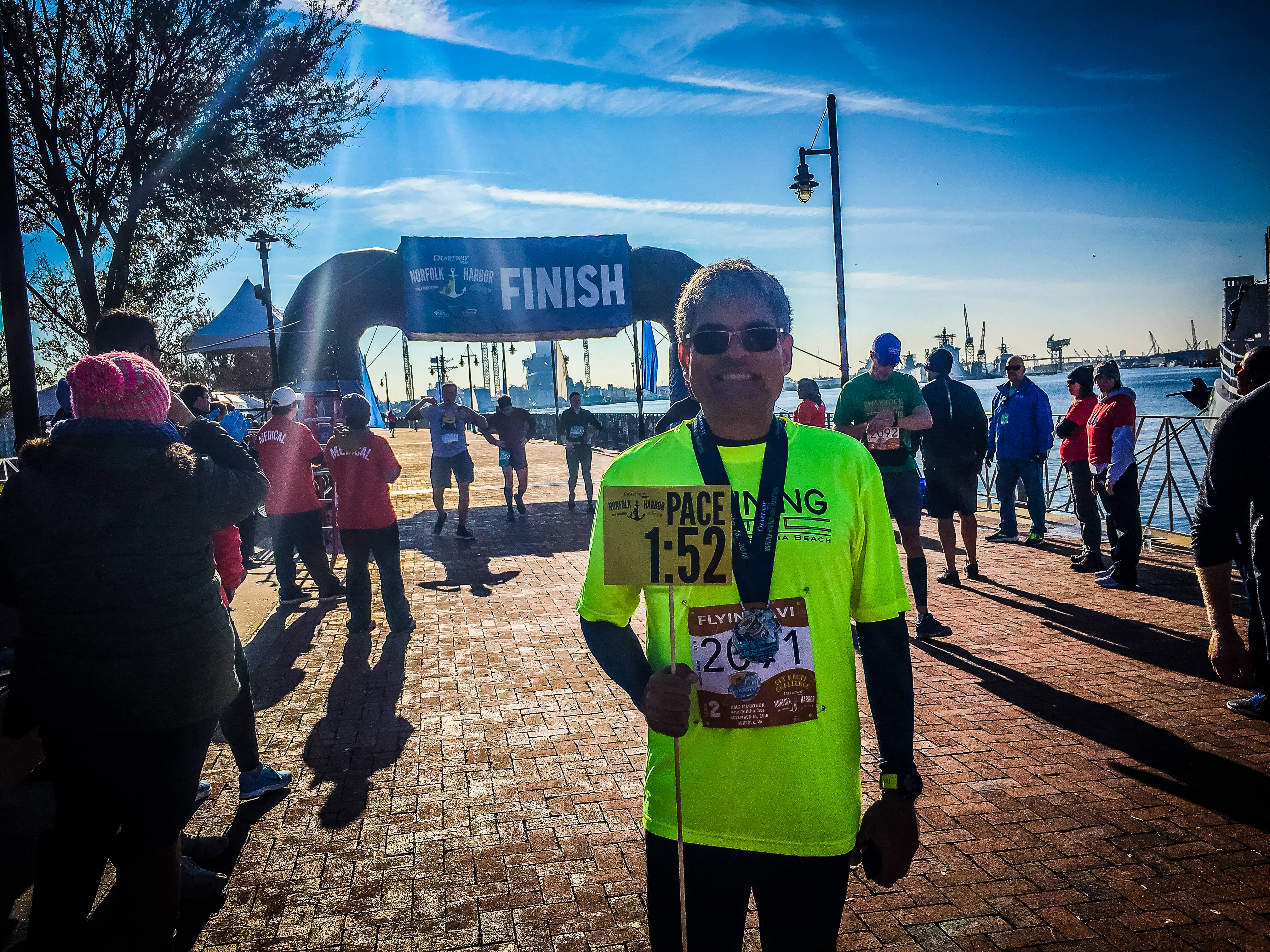
And this is priceless for a first-time racer.
“I think it’s super beneficial to have somebody there with you for race support, knowing that even when the going gets tough, you have someone there with you to kind of pull you along,” Sciance said.
Running can be a solo venture and when running a half or full marathon without a friend or knowing anyone, gets hard. We get stuck in our heads and need a distraction or someone to keep pushing us. You need someone to rely on. That person is the pacer.
How To Become A Pacer
The race entry is always free for a race pacer. And pacers get all the same swag as other participants. This includes the race t-shirt or other apparel, finisher medal, and access to the post-race party when applicable.
But how does a runner even become a pacer? For the most part, it’s all about word of mouth. After pacing a few races, event organizers often invite previous pacers back. Or another pacer refers the newer pacer to event organizers.
Sciance paces local races so she knows many of the race directors. This allows her to always be in the know when pacers are needed. She gets emails or finds out about opportunities on Facebook groups and in running groups.
More often than not its the race directors making the initial contact. And although most of the pacing gigs are through referrals, runners can also apply to become a pacer by contacting the race director.
Challenges And Rewards
The pacers featured here continue to train for their own personal races so they are always ready to pace the next race. But it doesn’t make it easy.
“I think the most difficult thing about pacing is staying consistent mile after mile after mile because especially in the later part of the race people get tired, even as a pacer,” Kelley said.
He added that it can be difficult to motivate others when also trying to keep them on pace. It’s easy to get lost in a story and forget to check the watch.
Mendelsohn agrees that the most challenging part is “staying on pace,” but he welcomes the challenge. “None of this is easy if you’re a pacer at the paces we are running at.”
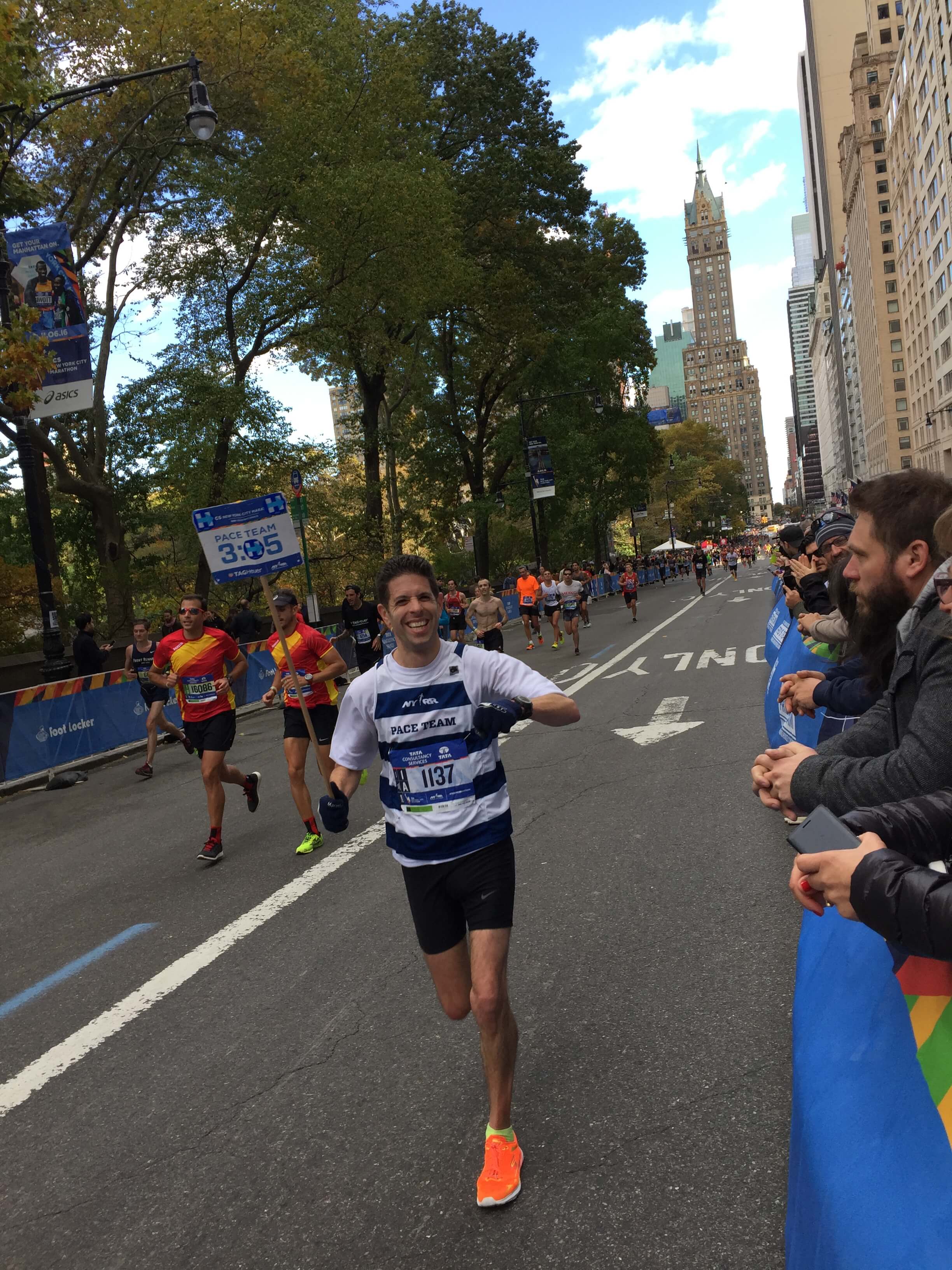
For him, it meant pacing the 1:20 group at the Brooklyn Half Marathon two years ago, an aggressive 6:10 average pace.
“I could not lose focus,” he said. Adding, “I needed to stay focused throughout, every mile, every half mile to be looking at my Garmin to make sure I didn’t slow down. I always try to do the fastest pace group and that is an intense pace even for me, even for most really good runners faster than me. So you have to stay focused on that pace.”
But the reward is worth it to cross that finish line with who have been training or months and watch them achieve their goal he said. “And to know that I helped them do it.”
Final Thoughts
During my conversations with pacers, I realized how crucial these types of runners are to races and participants. Their positive energy is magnetic, drawing a listener into their world where they embrace a pace and guide runners with them mile after mile. It’s hard to not be left feeling excited as a runner and to be grateful to be able to get to do what we do. I walked away with a newfound respect and amount of gratitude to these absolutely selflessly special runners.
Sources
- , WELCOME TO MARATHON MANIACS, Group Website
Latest Articles
 Is Running on a Treadmill Easier Than Running Outside?Runners have their own preferences, whether it is treadmill running, running outside on the road, or exploring trails. So...
Is Running on a Treadmill Easier Than Running Outside?Runners have their own preferences, whether it is treadmill running, running outside on the road, or exploring trails. So... Is It OK to Use Trail Running Shoes on the Road?While trail running shoes can be used on roads, especially in situations where a runner encounters mixed terrains or pref...
Is It OK to Use Trail Running Shoes on the Road?While trail running shoes can be used on roads, especially in situations where a runner encounters mixed terrains or pref... How to Fix Sore Quads After Running?Rest, ice, gentle stretching, and over-the-counter pain relievers can help soothe sore quads after running. Also, ensure ...
How to Fix Sore Quads After Running?Rest, ice, gentle stretching, and over-the-counter pain relievers can help soothe sore quads after running. Also, ensure ... 10 Fruits With The Most Electrolytes to Replace Sports DrinksThese fruits are high in electrolytes such as potassium, magnesium, and calcium, essential for hydration, muscle function...
10 Fruits With The Most Electrolytes to Replace Sports DrinksThese fruits are high in electrolytes such as potassium, magnesium, and calcium, essential for hydration, muscle function...

